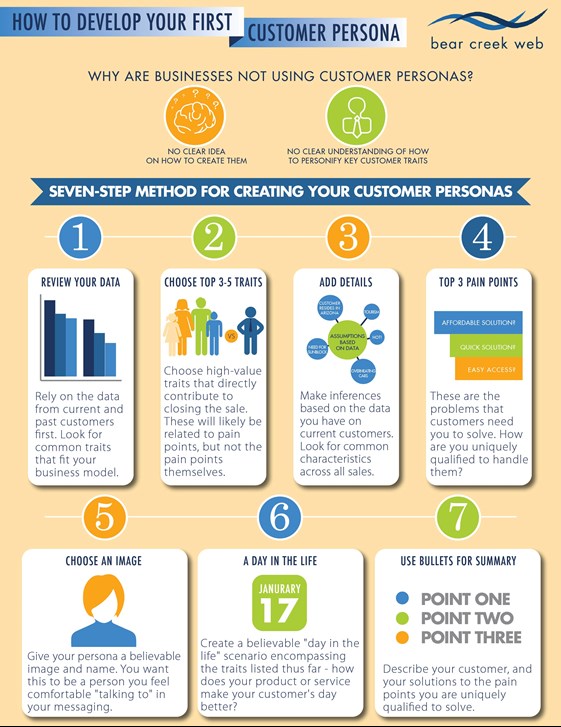One of the reasons so many businesses don’t use customer personas as a part of their web design process is simply because they don’t have a clear idea of how to create one.
The other reason is that it is difficult to sift through all your data to actually identify what the persona of your ideal client looks like. Initially, it may look like they have nothing in common until you really roll up your sleeves.
To help your team plan its online marketing initiatives, we’re sharing our five-step method for creating customer personas. Customer personas are a great way to refine and reevaluate your UVP, as you will start to see patterns that lead to the types of services and benefits your best clients value most.
Follow these steps to generate as many personas as you need:
- Review your data. Rely on your sales data first and other data that you may have second. Look at the traits your “ideal” current clients have in common. This will help your team create an accurate assessment of the types of people and companies that are your best potential clients. This is also a good time to make observations about those clients that have not been a good fit. The goal with creating the personas is to not only attract the ideal client, but to also be better skilled at not attracting the wrong client.
- Choose the top 3-5 traits. These are the traits that most of your ideal clients have in common. For example, if you are an attorney specializing in employment law, you may find your ideal client works for a small to medium size business in the services industry sector. You may also find that they are located within 50 miles of your office, and are typically the CFO. Whatever those attributes are, compile them and prioritize them by which ones apply to the most of your “idea” clients, and then pick the top 3-5. If you can come up with more traits that are relevant, great! However, we don’t recommend more than seven traits total as your persona may become too generalized.
- Add details. These are inferences you can make based on the data you have at hand. In the example above, you may know from experience that because they are the CFO and are very cost conscious. You may also know that because they are within 50 miles of your office, one of the reasons they selected you is because it was important for them to be able to easily have a face to face meeting. You may have a second persona identical to the first, but this person is typically an HR director. For that person, quick turnaround times may be more important than cost. In the end, you may have only one persona that really fits your ideal client profile, and that’s okay.If you have multiple personas, be sure to understand what each persona’s unique ‘hot buttons’ are. Each persona will have certain non-negotiable needs that are essential for their success. If you can position your UVP to successfully address these needs and go above and beyond the competition, you’ll turn more of your prospects into clients.
- List each persona and give it a name. You may have Carol the CFO and Henry the HR Director. Now it’s time to fill in additional details for each. Perhaps the CFO is almost always from a software startup and the HR director is exclusively from construction companies. Build the rest of the details of what this person looks like. What are their hobbies? Are they married or single? What kind of car do they drive? All these details help you better envision what this person looks like and what might be important to them.
- Choose a representative image. You know all those stock images of smiling people that are so readily available online? Pick a believable face to go with the profile you are creating. Putting a face on the avatar makes it that much more personal and makes it easier to create content that builds trust between your brand and your potential customers.
To help your team keep these steps in mind, we’ve created a handy downloadable infographic illustrating these five steps (with two bonus steps to guide your UVP positioning). Feel free to share, and drop us a line to let us know if it helps your team create more believable personas.


